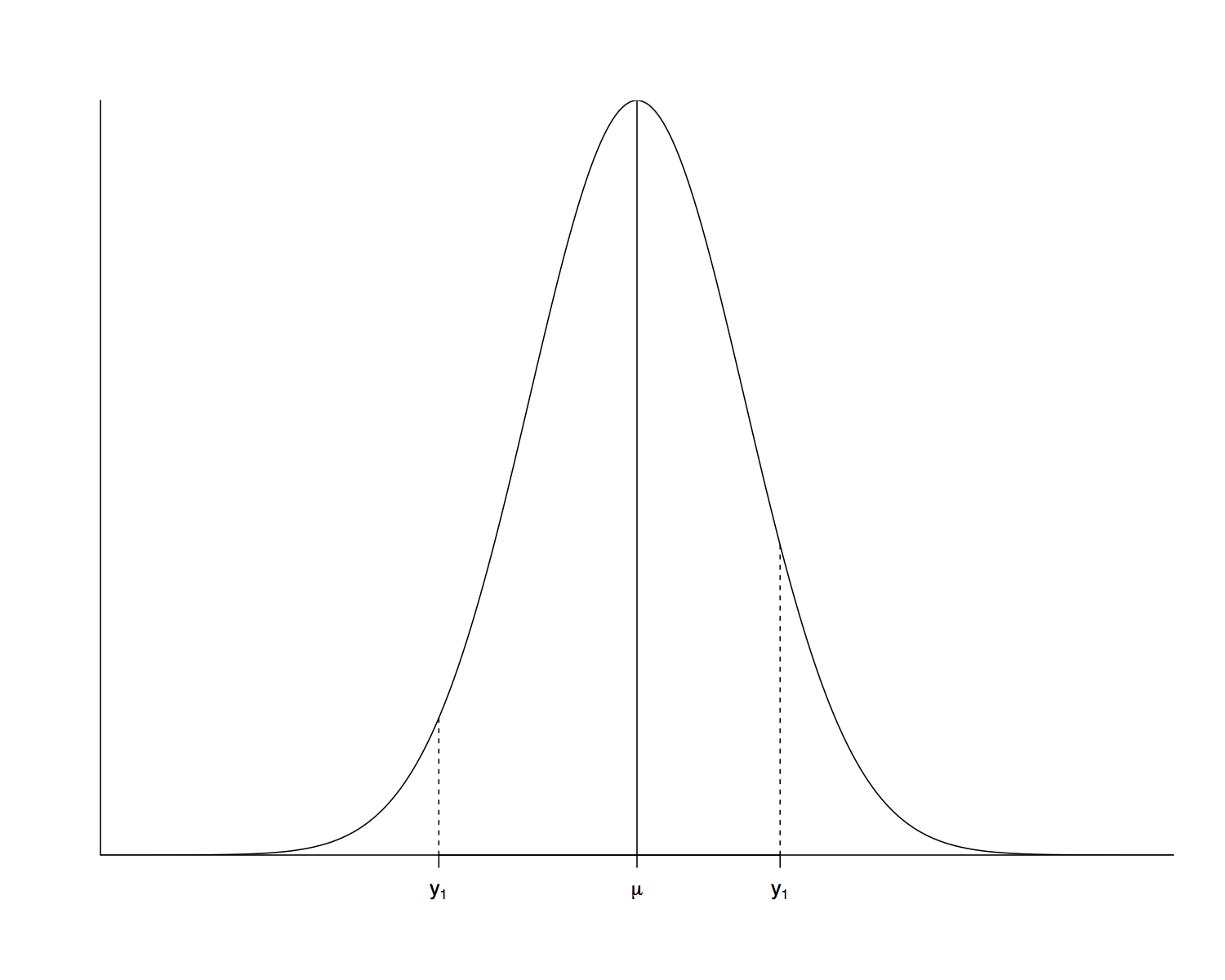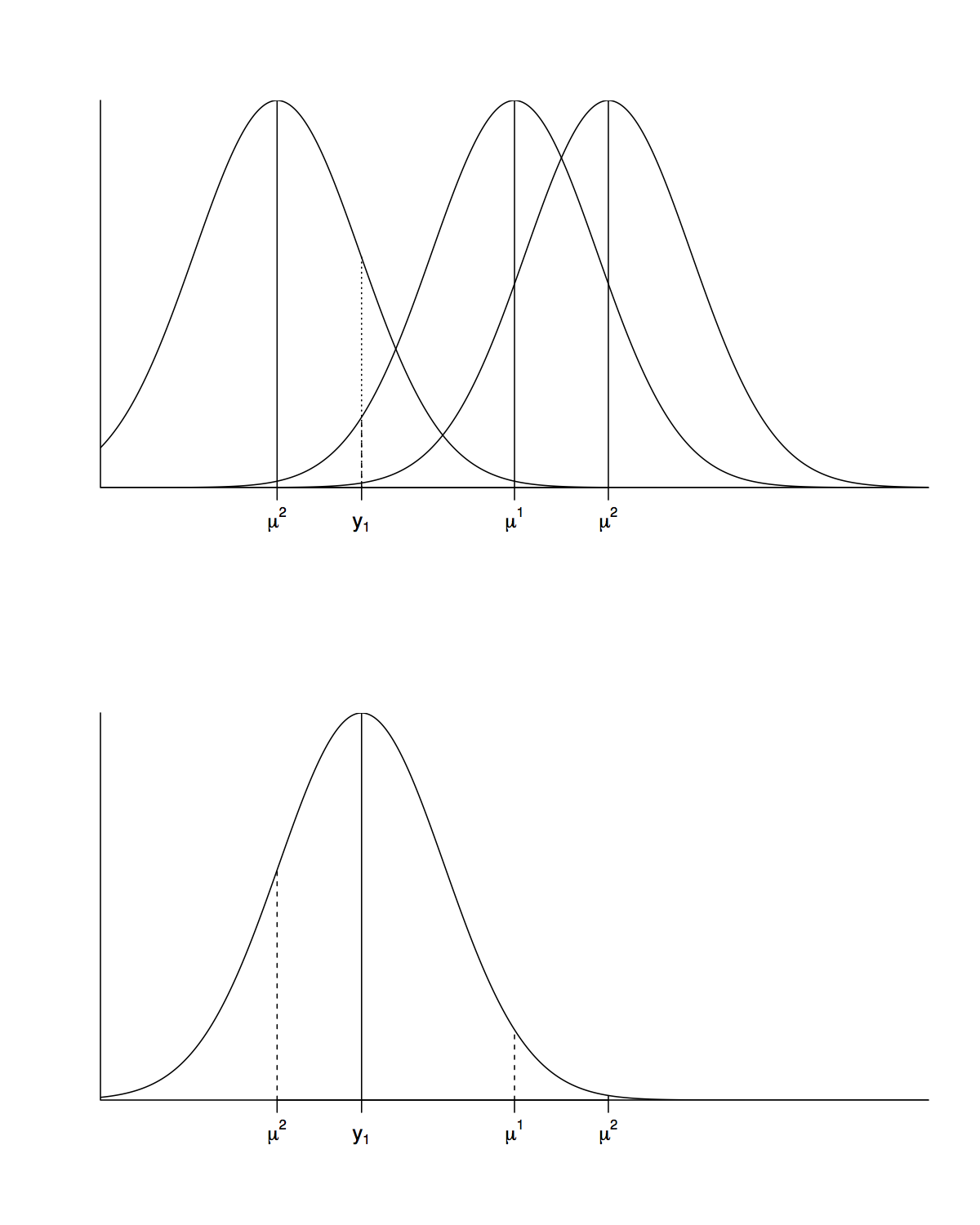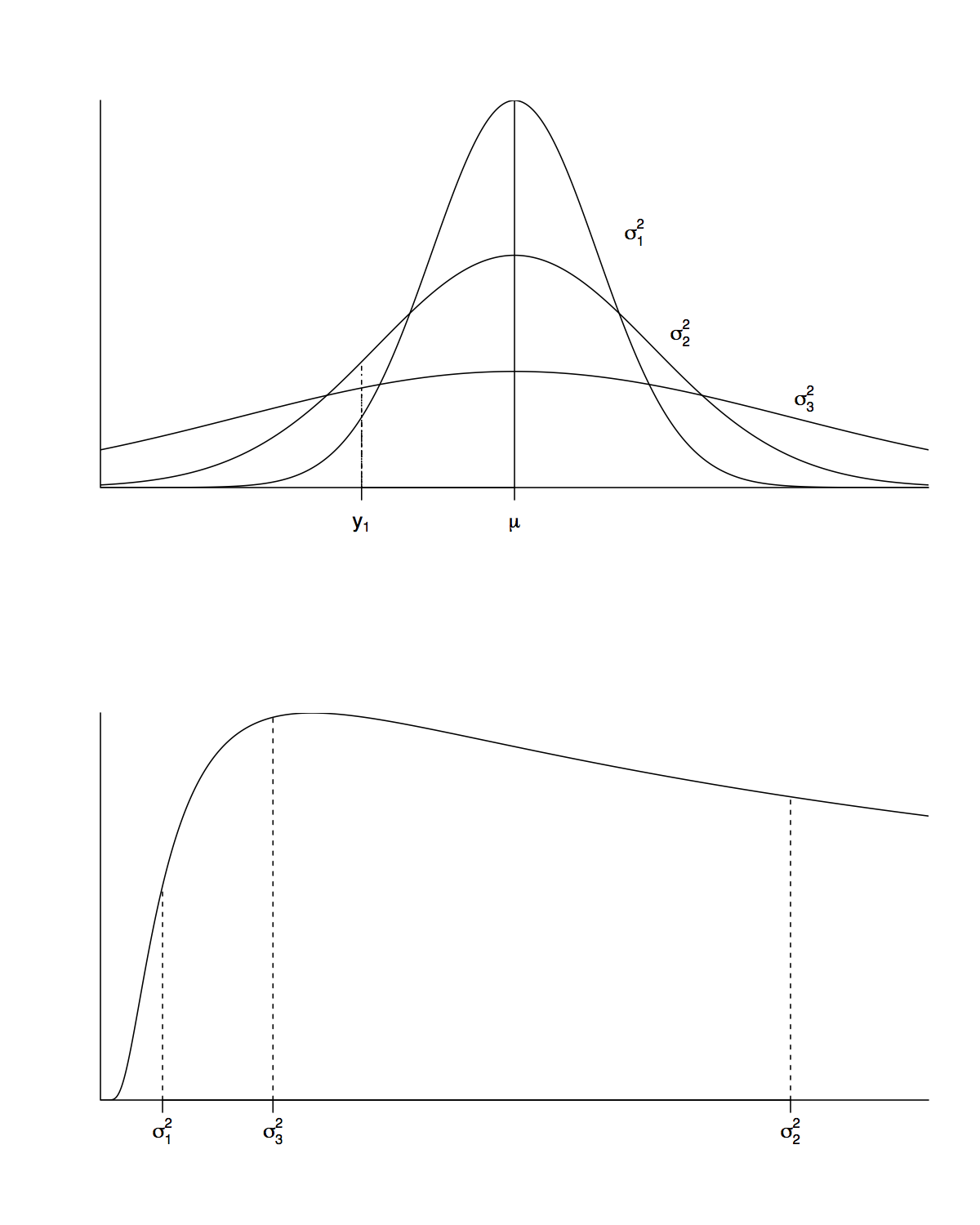Maximum Likelihood Estimation¶
Estimating Parameters of Distributions¶
We almost never know the true distribution of a data sample.
- We might hypothesize a family of distributions that capture broad characteristics of the data (locations, scale and shape).
- However, there may be a set of one or more parameters of the distribution that we don’t know.
- Typically we use the data to estimate the unknown parameters.
Joint Densities¶
Suppose we have a collection of random variables \({\bf Y} = (Y_1, \ldots, Y_n)'\).
- We view a data sample of size \(n\) as one realization of each random variable: \({\bf y} = (y_1, \ldots, y_n)'\).
- The joint cumulative density of \({\bf Y}\) is
Joint Densities¶
- The joint probability density of \({\bf Y}\) is
since
Independence¶
When \(Y_1, \ldots, Y_n\) are independent of each other and have identical distributions:
- We say that they are independent and identically distributed, or i.i.d.
- When \(Y_1, \ldots, Y_n\) are i.i.d., they have the same marginal densities:
Independence¶
Further, when \(Y_1, \ldots, Y_n\) are i.i.d.
- This is analogous to the computation of joint probabilities.
- For independent events \(A\), \(B\) and \(C\),
Maximum Likelihood Estimation¶
One of the most important and powerful methods of parameter estimation is maximum likelihood estimation. It requires
- A data sample: \({\bf y} = (y_1, \ldots, y_n)'\).
- A joint probability density:
where \({\bf \theta}\) is a vector of parameters.
Likelihood¶
\(f_{{\bf Y}}({\bf y}|{\bf \theta})\) is loosely interpreted as the probability of observing data sample \({\bf y}\), given a functional form for the density of \(Y_1, \ldots, Y_n\) and given a set of parameters \({\bf \theta}\).
- We can reverse the notion and think of \({\bf y}\) as being fixed and \({\bf \theta}\) some unknown variable.
- In this case we write \(\mathcal{L}({\bf \theta}|{\bf y}) = f_{{\bf Y}}({\bf y}|{\bf \theta})\).
- We refer to \(\mathcal{L}({\bf \theta}|{\bf y})\) as the likelihood.
- Fixing \({\bf y}\), maximum likelihood estimation chooses the value of \({\bf \theta}\) that maximizes \(\mathcal{L}({\bf \theta}|{\bf y}) = f_{{\bf Y}}({\bf y}|{\bf \theta})\).
Likelihood Maximization¶
Given \({\bf \theta} = (\theta_1, \ldots, \theta_p)'\), we maximize \(\mathcal{L}({\bf \theta}|{\bf y})\) by
- Differentiating with respect to each \(\theta_i\), \(i = 1, \ldots, p\).
- Setting the resulting derivatives equal to zero.
- Solving for the values \(\hat{\theta}_i\), \(i = 1, \ldots, p\), that make all of the derivatives zero.
Log Likelihood¶
It is often easier to work with the logarithm of the likelihood function.
- By the properties of logarithms
Log Likelihood¶
- Maximizing \(\ell({\bf \theta}|{\bf y})\) is the same as maximizing \(\mathcal{L}({\bf \theta}|{\bf y})\) since \(\log\) is a monotonic transformation.
- A derivative of \(\mathcal{L}\) will involve many chain-rule products, whereas a derivative of \(\ell\) will simply be a sum of derivatives.
MLE Example¶
Suppose we have a dataset \({\bf y} = (y_1, \ldots, y_n)\), where \(Y_1, \ldots, Y_n \stackrel{i.i.d.}{\sim} \mathcal{N}(\mu, \sigma^2)\).
- We will assume \(\mu\) is unknown and \(\sigma\) is known.
- So, \({\bf \theta} = \mu\) (it is a single value, rather than a vector).
MLE Example¶
- The likelihood is
MLE Example¶
The log likelihood is
MLE Example¶
- The MLE, \(\hat{\mu}\), is the value that sets \(\frac{d}{d \mu} \ell(\mu|{\bf y}) = 0\):
MLE Example: \(n=1\), Unknown \(\mu\)¶
Suppose we have only one observation: \(y_1\).
- If we specialize the previous result:
- The density \(f_{Y_1}(y_1|\mu)\) gives the probability of observing some data value \(y_1\), conditional on some known parameter \(\mu\).
- This is a normal distribution with mean \(\mu\) and variance \(\sigma^2\).
MLE Example: \(n=1\), Unknown \(\mu\)¶
- The likelihood \(\mathcal{L}(\mu|y_1)\) gives the probability of \(\mu\), conditional on some observed data value \(y_1\).
- This is a normal distribution with mean \(y_1\) and variance \(\sigma^2\).
MLE Example: \(n=1\)¶
MLE Example: \(n=1\), Unknown \(\mu\)¶
MLE Example: \(n=1\), Unknown \(\sigma\)¶
Let’s continue with the assumption of one data observation, \(y_1\).
- If \(\mu\) is known but \(\sigma\) is unknown, the density of the data, \(y_1\), is still normal.
- However, the likelihood is
- The likelihood for \(\sigma^2\) is not normal, but inverse gamma.
MLE Example: \(n=1\), Unknown \(\sigma\)¶
MLE Accuracy¶
Maximum likelihood estimation results in estimates of true unknown parameters.
- What is the probability that our estimates are identical to the true population parameters?
- Our estimates are imprecise and contain error.
- We would like to quantify the precision of our estimates with standard errors.
- We will use the Fisher Information to compute standard errors.
Fisher Information¶
Suppose our likelihood is a function of a single parameter, \(\theta\): \(\mathcal{L}(\theta|{\bf y})\).
- The Fisher Information is
- The observed Fisher Information is
Fisher Information¶
- Observed Fisher Information does not take an expectation, which may be difficult to compute.
- Since \(\ell(\theta|{\bf y})\) is often a sum of many terms, \(\widetilde{\mathcal{I}}(\theta)\) will converge to \(\mathcal{I}(\theta)\) for large samples.
MLE Central Limit Theorem¶
Under certain conditions, a central limit theorem holds for the MLE, \(\hat{\theta}\).
- For infinitely large samples \({\bf y}\),
- For large samples, \(\hat{\theta}\) is normally distributed regardless of the distribution of the data, \({\bf y}\).
MLE Central Limit Theorem¶
- \(\hat{\theta}\) is also normally distributed for large samples even if \(\mathcal{L}(\theta|{\bf y})\) is some other distribution.
- Hence, for large samples,
MLE Standard Errors¶
Since we don’t know the true \(\theta\), we approximate
- Alternatively, to avoid computing the expectation, we could use the approximation
MLE Standard Errors¶
- In reality, we never have an infinite sample size.
- For finite samples, these values are approximations of the standard error of \(\hat{\theta}\).
MLE Variance Example¶
Let’s return to the example where \(Y_1, \ldots, Y_n \stackrel{i.i.d.}{\sim} \mathcal{N}(\mu, \sigma^2)\), with known \(\sigma\).
- The log likelihood is
- The resulting derivatives are
MLE Variance Example¶
In this case the Fisher Information is identical to the observed Fisher Information:
- Since \(\mathcal{I}(\mu)\) doesn’t depend on \(\mu\), we don’t need to resort to an approximation with \(\hat{\mu} = \bar{{\bf y}}\).
- The result is


